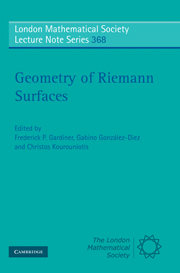Book contents
- Frontmatter
- Contents
- Preface
- Foreword
- Semisimple actions of mapping class groups on CAT(0) spaces
- A survey of research inspired by Harvey's theorem on cyclic groups of automorphisms
- Algorithms for simple closed geodesics
- Matings in holomorphic dynamics
- Equisymmetric strata of the singular locus of the moduli space of Riemann surfaces of genus 4
- Diffeomorphisms and automorphisms of compact hyperbolic 2-orbifolds
- Holomorphic motions and related topics
- Cutting sequences and palindromes
- On a Schottky problem for the singular locus of A5
- Non-special divisors supported on the branch set of a p-gonal Riemann surface
- A note on the lifting of automorphisms
- Simple closed geodesics of equal length on a torus
- On extensions of holomorphic motions—a survey
- Complex hyperbolic quasi-Fuchsian groups
- Geometry of optimal trajectories
- Actions of fractional Dehn twists on moduli spaces
Foreword
Published online by Cambridge University Press: 05 May 2013
- Frontmatter
- Contents
- Preface
- Foreword
- Semisimple actions of mapping class groups on CAT(0) spaces
- A survey of research inspired by Harvey's theorem on cyclic groups of automorphisms
- Algorithms for simple closed geodesics
- Matings in holomorphic dynamics
- Equisymmetric strata of the singular locus of the moduli space of Riemann surfaces of genus 4
- Diffeomorphisms and automorphisms of compact hyperbolic 2-orbifolds
- Holomorphic motions and related topics
- Cutting sequences and palindromes
- On a Schottky problem for the singular locus of A5
- Non-special divisors supported on the branch set of a p-gonal Riemann surface
- A note on the lifting of automorphisms
- Simple closed geodesics of equal length on a torus
- On extensions of holomorphic motions—a survey
- Complex hyperbolic quasi-Fuchsian groups
- Geometry of optimal trajectories
- Actions of fractional Dehn twists on moduli spaces
Summary
A Riemann surface is a thing of beauty, possessing geometric shape as well as analytic or algebraic structure. From its introduction in 1851 in Riemann's inaugural dissertation, his first great work establishing the foundations of geometric complex analysis, the concept has exerted an unusual influence as a powerful clarifying mental tool.
Today, the pervasive role of complex analysis in the mathematical and physical sciences has brought these ideas into a significance wider than even their founder could have predicted. In the present book, the reader will find a selection of results which can only indicate the part currently played by surfaces and their spaces of deformations: just as a single convergent power series is enough to generate by continuation an entire Riemann surface structure, so the foundational ideas of our discipline extend and evolve beyond our present view of them.
Central to the contemporary study of Riemann surfaces is the interplay between different aspects, geometric ideas and algebraic or analytical calculations, leading to insights into the deeper properties these objects possess. The basic notion provides a topological base for deploying the most powerful ideas of algebra, geometry and analysis: indeed it establishes a central role for topology in bringing about a unique mathematical synthesis. A single accessible theory serves to interconnect complex analysis and the various algebraic invariants, the fundamental group, field of functions, homology and period lattices. In the reassuring familiarity of a two dimensional framework, we have a global base for complex analytic and covering space methods, interacting with Galois-theoretic properties of the function field.
- Type
- Chapter
- Information
- Geometry of Riemann Surfaces , pp. ix - xxPublisher: Cambridge University PressPrint publication year: 2010



